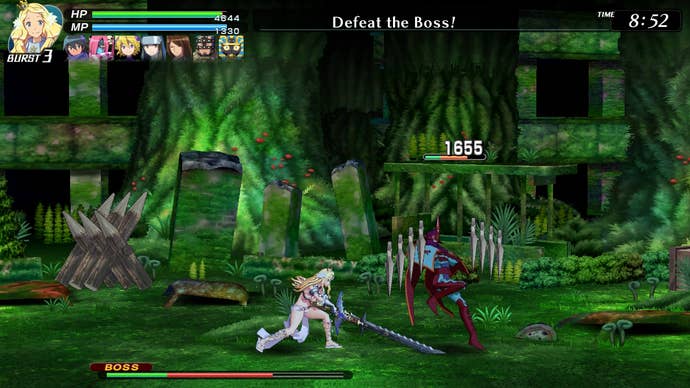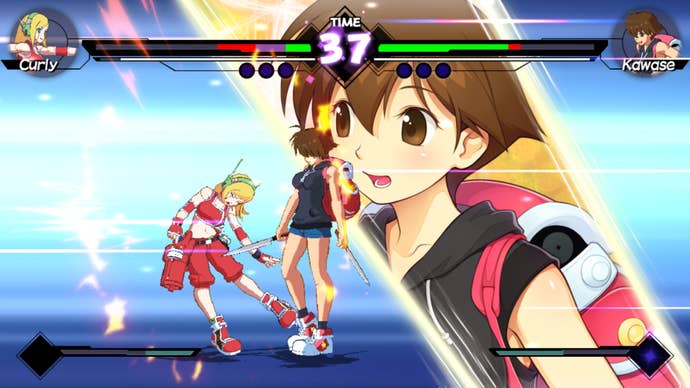Cave Story Publisher Nicalis Brings an Eclectic Slate of Games to the West
Nicalis' BitSummit 2018 showing in Japan had a big emphasis on Switch games too.
This article first appeared on USgamer, a partner publication of VG247. Some content, such as this article, has been migrated to VG247 for posterity after USgamer's closure - but it has not been edited or further vetted by the VG247 team.
The games publisher Nicalis recently celebrated its 10th anniversary, and the company has grown considerably over the past few years. The scheduling issues and delays that often beset the publisher's early days appear to be a thing of the past, and the considerable selection of titles on display at the company's shared booth at this year's BitSummit in Japan covered a fairly wide range of genres and styles. A few titles are even promising remarkably quick turnaround times from announcement to launch. In fact, Ikaruga was announced a little over a week ago and is already launching at the end of the month.
There are really just a couple of common threads running through Nicalis's roster of games. First, they largely have a retro bent, whether that manifests in terms of mechanics, genre, or visuals. Secondly, each and every one of their games is slated for release on Switch, often with a retail package release in the cards. Many of them are also due for PlayStation 4 and Steam, but Switch has quickly become the company's mainstay. "Switch has been very good to us," Nicalis producer Monica Marume says, "and we want to be sure to continue supporting the platform."

Ikaruga
Developed by: Treasure
Release date: May 2018
Perhaps the most heartwarming sight of many on display at BitSummit this year, Ikaruga enjoyed its own custom setup at the Nicalis booth: The game is running on a huge LCD screen flipped sideways. As with many vertical shooters hailing from the arcades, Ikaruga was designed for a vertical monitor, something the Switch can support natively thanks to the option to remove the Joy Cons from the system and place the screen unit on a vertical stand.
Ikaruga debuted in arcades nearly two decades ago, but the Switch remaster doesn't look at all dated. The game's lighting effects and color-based gimmick scale up nearly to modern hardware, resulting in a clean, appealing shooter. The Switch port appears to be a direct conversion of the previous home ports, with the same stage layouts, bullet patterns, and play mechanics. Ikaruga's central hook involves managing enemies and hazards that appear in two different colors, or polarities: black or white. The player's ship can reverse its polarity with the press of a button. Firing at an enemy of the opposite polarity will inflict double damage, while bullets of a like color pose no threat to the player and are simply absorbed into their ship's shield. This sounds simple in theory, but Ikaruga takes the form of a bullet hell shooter and it doesn't take long to begin filling the screen with an almost impossible array of multi-colored bullets and enemies to destroy.
According to Marume, Ikaruga's Switch conversion is being programmed in-house at developer Treasure. This should come as a relief to fans who worried Treasure had shut down thanks to the studio's silence after publishing a pair of poorly received, import-only 3DS games under the name Gaist Crusher. They are, in fact, still alive... at least in some form.

Code of Princess EX
Developed by: Studio Saizensen
Release date: Summer 2018
The first of several remasters Nicalis has on their docket, Code of Princess EX brings a niche 3DS game to Switch in a much-improved form. The original Code of Princess featured a fantasy brawler gameplay reminiscent of Treasure's Guardian Heroes for Saturn, but it suffered from some less-than-inspiring tech limitations. The on-screen sprites appeared as barely legible pixel blobs on 3DS, and the whole thing ran at a glacial pace. While character animations remain pretty choppy in this remake, the surrounding game runs a lot more smoothly and the higher resolution on Switch makes it possible to tell what the characters actually look like.
Code of Princess is most infamous for the design of its lead character, Solange. Designed by long-time Capcom illustrator Kinu Nishimura, Solange is a voluptuous warrior princess wearing practically nothing, and her risqué appearance is a lot more obvious this time around. She's an interesting character to play as, though, because she breaks the stereotype that petite, barely clad women in fantasy games fall into to weak/nimble category. That classification belongs to Ali Vava, a rogue who looks remarkably similar to the thief class in Capcom's Dungeons & Dragons brawlers from the ’90s (a game whose characters Nishimura also designed). Solange, on the other hand, plays more as the hulking barbarian type: slow, powerful, dragging around a broadsword as large as she is.
The remake appears to suffer from the repetitive play that affected the original (and, generally speaking, most games in the brawler genre), but it's still interesting to see this particular game get a second shot at life. Given the game's deep roots—the Guardian Heroes connection comes from sharing staff with that classic—it's likely appeal to fans of ’90s brawlers.

Super 1001 Spikes EX
Developed by: 8bits Fanatics
Release date: 2018
Super 1001 Spikes EX is a slightly beefed-up Switch port of a trap-action platformer that made its way to most platforms last generation. The pixel art style of the game speaks to its old-school mentality—it delights in murdering the player at every possible turn. Spikes, poison darts, monsters, falling blocks, and more pop up to kill players without a moment's notice, and each level of the game becomes an exercise in painful trial-and-error. While I'm normally averse to trial-and-error design, it works here because 1001 Spikes was designed through careful observation of test plays. Wherever a player assumes they can pause for a second to take a breather or duck out of harm's way, some sort of horrible death trap will spring into action to punish their impudence. The entire thing has a wry sense of humor that reflects its creator's personality; I remember watching the designer of 1001 Spikes observe players at PAX long ago, cackling with delight every time someone wandered into an untelegraphed trap. And he continues to refine his cruel craft; I'm told Super 1001 Spikes EX remixes its stages to switch up the location of traps, just to keep players guessing.

Blade Strangers
Developed by: Studio Saizensen
Release date: 2018
Nicalis has developed a strong partnership with Studio Saizensen, perhaps best known as the company behind the most recent releases of Umihara Kawase, and Blade Strangers plays like an expression of their holy matrimony. A 2D fighting game featuring combatants from both companies' stable of characters, Blade Strangers falls very much into the niche doujin fighting game genre, à la Melty Blood. Sprite-based characters battle it out one-on-one atop polygonal backgrounds, with pretty solid animation and sprite art marred only by the tendency of the screen scaling to warp the fine details of the pixel-art characters.
From my brief hands-on, Blade Strangers feels like a fairly nuts-and-bolts take on the fighting genre. There are no wild 1,000-hit combos or tagged-in companion helpers, just two people punching one another a whole lot. It's hard for me to judge the quality of the fighting since my demo pitted me against A.I. set to "very hard," which immediately savaged me while I was busy trying to figure out my selected character's basic move set.
Still, the controls feel responsive even between ruthless combo strikes by a high-level A.I. opponent, and each characters' actions seem nicely representative of the source material. Isaac (from Binding of Isaac, a truly unexpected source for a fighting game character if ever there was one) attacks with lots of tears and other bodily functions, while Umihara Kawase relies mostly on melee strikes supplemented by her fishing wire, which works a bit like a whip. Overall, it's a pretty decent first attempt at a fighter by Studio Saizensen, although the weird mix of characters doesn't seem to have gone over entirely well with many fans of those respective series.

Crystal Crisis
Developed by: Nicalis
Release date: Fall 2018
Forget Blade Strangers, though. This has to be the single strangest entry on the Nicalis roster. An internally developed title, Crystal Crisis is nothing more or less than a naked rip-off of Capcom's Super Puzzle Fighter 2. A head-to-head puzzler, Crystal Crisis demands players to manage pairs of colored gems as they fall, rotating them to create connected lumps of like colors. As in Puzzle Fighter, simply placing colors adjacent to one another doesn't cause them to clear away off the screen (though you can create larger fused blocks by creating squares of uniform color). Instead, you must wait for special gems to drop, which will clear away adjacent like-colored blocks and all blocks of that color to which the vanishing block is connected. It's possible in this way to clear enormous swaths of the screen, which in turn sends those deleted blocks over to your opponent's side for them to have to clear out.
More surprising than the game's considerable similarities to Puzzle Fighter is the absolutely bonkers lineup of characters it features. As with Puzzle Fighter, Crystal Crisis gives each player an avatar, each of whom has his or her own unique pattern of falling blocks to deal with—that is to say, a specific order of colored blocks and frequency with which gems appear. That's to be expected, but this is easily the most bizarre crossover since the time Square Enix got its Disney in my Final Fantasy. In addition to Nicalis mainstays like Quote from Cave Story, Eban Hawkins from 1001 Spikes, and Solange from Code of Princess, Crystal Crisis also boasts the presence of Johnny Turbo, the bearded advertising "mascot" NEC used in a bizarre series of anti-SEGA attack ads to promote the TurboGrafx-16 back in the ’90s. At the other extreme, you also have Astro Boy and Black Jack, two legendary manga characters created by the late Osamu Tezuka. Where Johnny Turbo is obscure in the U.S. and unknown in Japan, Astro Boy has cultural cachet approaching Mickey Mouse in his homeland. Seeing these icons go toe-to-toe with a joke ad mascot from 25 years ago and the cast of indie darling Cave Story is surreal, to say the least. The proof is in the play, though, and Crystal Crisis does play well.

Runner 3
Developed by: Choice Provisions
Release date: May 2018
The latest entry in Choice Provisions' extremely truth-in-naming platforming action series features colorful, polygon graphics similar to Bit.Trip Runner 2, but this time it includes branching paths within each stage.

Save Me Mr. Tako
Developed by: Christophe Galati
Release date: 2018
And finally, this charming little Game Boy-inspired platformer appeared this year at its second consecutive BitSummit. I spoke to the game's designer last year, and he spoke hopefully about the prospects of the game (which stars an octopus that acquires different powers by donning hats) finding a publisher. That role ultimately went to Nicalis, who picked up the game for Switch and PC.




_ddwYK80.png?width=291&height=164&fit=crop&quality=80&format=jpg&auto=webp)



